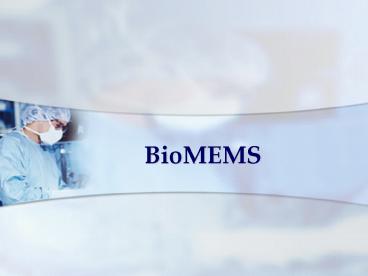BioMEMS - PowerPoint PPT Presentation
1 / 35
Title:
BioMEMS
Description:
The interface between biology and microtechnology encompasses ... target molecule and a biological macromolecule (e.g. enzyme, antibody, receptor or DNA strand) ... – PowerPoint PPT presentation
Number of Views:1314
Avg rating:3.0/5.0
Title: BioMEMS
1
BioMEMS
2
BioMEMS
- MEMS is being applied to biomedical applications
and has become a new field of research unto
itself. - The interface between biology and microtechnology
encompasses many diverse areas and levels of
biological complexity. - Include DNA arrays (genes), immmunoassays
(proteins), miniaturized lab-on-a-chips (genes,
proteins, and sensors), and finally the
integration of live cells (bacterial and
mammalian) with semiconductor materials and
components.
Immmunoassays ????
3
Definition of BioMEMS
4
Microfluidics Applications
5
Market
- Several market studies are available for BioMEMS,
biochips, lab-on-chips, µTAS Definitions are
varying, however, they all predict a rapidly
growing and high market for microtechnologies in
life sciences. - For instance, NEXUS is predicting that the market
for In Vitro Diagnostics (IVD) will grow from US
1,9 billion in 2000 to US 9.9 billion in 2005.
6
Biosensors
- A biosensor is an analytical device which
converts a biological response into an
electrical signal - Biosensors are devices that can detect and/or
quantify - molecules of interest.
- Sensing occurs when there is an interaction
between the - target molecule and a biological macromolecule
- (e.g. enzyme, antibody, receptor or DNA
strand).
7
Biosensor application
- Some of the most intense application in biosensor
are diverse as blood glucose monitoring,
explosive detection, food quality determination,
genetic screening, and environmental monitoring.
8
The components of biosensor
- (1) The sensitive biological element.
- (biological material tissue,
micro-organisms, organelles, cell receptors,
enzymes, antibodies, nucleic acids etc ). - (2) The transducer in between.
- (3) The detector element.
9
Biosensor types
- Immunosensor - Immunosensors transduce
antigen-antibody interactions directly into
physical signals.
(Left) Antibodies labelled with microperoxidase
MP11 for generation of the electrochemical
signal via electrocatalytic reduction of H2O2
10
(No Transcript)
11
Optical- immunosensor
12
Enzyme biosensor
- Enzyme was used to demonstrate the selectivity of
analytes. - The transduced signal varies with the rate of
reaction of analyte with certain enzyme.
13
- Advantages
- more specific than cell based sensors
- faster responds due to shorter diffusion paths
(no cell walls) - Disadvantages
- more expensive to produce due to the additional
problem of isolating the enzyme - enzymes are often unstable when isolated
- many enzymes need cofactors for the detection of
substances
14
E1 Urease E2 Penicillinase
An enzyme sensor used to detect the
concentration of urea and penicillin-V
15
DNA microarrays (Gene chip)
- A rapid method to read out from the gene strand.
- Microarray technology now allows us to exam many
genes at once and determine which are expressed
in a particular cell type. - DNA molecules representing many genes are placed
in discrete spots on a microscope slide. This is
called a microarray. - The RNA molecules are then "labeled" by attaching
a fluorescent dye that allows us to see them
under a microscope, and added to the DNA dots on
the microarray.
16
The DNA molecular
17
(No Transcript)
18
(No Transcript)
19
(left) The intensity and color of each spot
encode information on a specific gene from the
tested sample
20
Lab-on-a-chip (Microfluidic)
- Is a term for devices that integrate (multiple)
laboratory functions on a single chip of only
millimeters to a few square centimeters in size. - Capable of handling extremely small fluid volumes
down to less than pico liters. - Lab-on-a-chip devices are a subset of MEMS
devices and often indicated by "Micro Total
Analysis Systems" (µTAS) as well.
21
- Advantages of LOCs
- Low fluid volumes consumption and less sample
fluid is used for diagnostics - (2) Higher analysis and control speed of the chip
and better efficiency. - (3) Better process control because of a faster
response of the system. - (4) Large integration of functionality and small
volumes. - (5) Massive parallelization due to compactness,
which allows high-throughput - analysis.
- (6) Lower fabrication costs, allowing
cost-effective disposable chips. - (7) Safer platform for chemical, radioactive or
biological studies. - Disadvantages of LOCs
- (1) Novel technology and therefore not fully
developed yet. - (2) Physical effects like capillary forces and
chemical effects of channel surfaces - become more dominant and make LOC systems
behave differently - and sometimes more complex than
conventional lab equipment - (3) Detection principles may not always scale
down in a positive way, - leading to low signal to noise ratios.
22
(upper) This "Lab-on-a Chip" electrophoresis
device allows mixtures of DNA or proteins to be
separated at 1 of the time required by
conventional capillary electrophoresis while
using much less sample.
23
(No Transcript)
24
(No Transcript)
25
Microfludic design
- Viscosity of fluids -
26
If m is constant, the fluid is called newtonian
fluid.
27
- For newtonian fluid,
28
Reynolds Number
- The Reynolds Number is defined as
- If 10lt Relt100 compressive fluid
- Re lt 1000 incompressive fluid
29
Continuity equation
- For incompressive fluid
30
Example 1
31
(No Transcript)
32
Bernoulli equation
- Bernoulli equation is the equation of motion to
calculate the pressure needed to drive the force
in the micro-channel.
33
Example 2
34
(No Transcript)
35
Surface tension
- Surface tension is due to the cohesion force in
between the fluid molecular.






























![[PDF] Introduction to BioMEMS 1st Edition Android PowerPoint PPT Presentation](https://s3.amazonaws.com/images.powershow.com/10079363.th0.jpg?_=20240716084)
